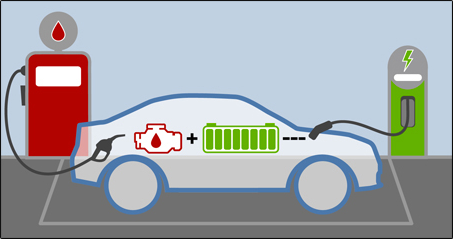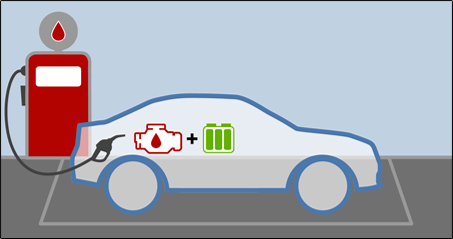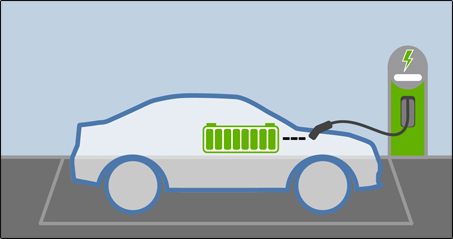The majority of cars on the road today are conventional gasoline/diesel vehicles. These vehicles are powered from a gasoline-fueled engine and are refueled at gas stations. They produce higher amounts of GHGs because of the combustion of gasoline or diesel within the engine. These vehicles typically have lower fuel economy than hybrids and plug-ins.
HEVs are primarily fueled by a traditional gasoline or diesel engine that is combined with an electric motor and a battery that recharges when you slow down or brake. This results in using less fuel than competing models with a conventional gasoline engine alone. The electric motor provides extra power to the engine, which gives hybrids a higher engine efficiency than most vehicles with conventional gas engines. HEVs do not need to be plugged in, and they often have a longer range than most gasoline vehicles.

PHEVs are similar to HEVs in that they can run on a conventional gasoline engine and a battery-powered electric motor, but they can be plugged into an outlet to recharge the battery. All new models can run on only electricity, with ranges from about 10–100 miles. However, some PHEVs have more electric power than others. The most powerful ones can run all electrically even if driven aggressively. All are also capable of operating with only gasoline fuel, but will have the best fuel economy and emit fewer GHGs when using the all-electric mode. PHEVs can be plugged into a standard household plug, known as Level 1 charging. Faster charging, or Level 2, can also be installed in the home to charge PHEVs. Learn more about charging here (no link).

These types of BEVs contain a small engine that acts as a range extender by providing power to a generator that delivers electricity to the battery. In everyday driving this vehicle type will consistently be fueled only by electricity, with little or no need for a second charge in the day. The gasoline engine in the two available range extender EVs that have this characteristic (50–100 mile range) provides the ability to drive between cities without stopping to recharge. However, the “BEVx” version, with the higher amount of electrical range, saves money on its gasoline option, having less gasoline range than electric range. It might be used for nearby rural recreation trips, but not for long-distance intercity trips.

BEVs only utilize a large battery to power the electric motor. They are charged by plugging into an electric power source, and because they do not use gasoline, no GHGs are emitted from tailpipes. The range can extend up to more than 300 miles, depending on the vehicle. More range generally costs more money, but it also generally provides better acceleration. Although you can charge most EVs with a household plug, there is also the option of a Level 2 charging unit that can be installed in the home. Most BEVs, but not all, also can be “fast charged” at public locations. Do not be deterred from purchasing an EV because you do not have a high-power charging circuit close to your parking spot. If you have a plug handy and an all-electric vehicle fits your daily driving needs, consider it along with PHEVs. Learn more about charging here (no link). BEVs require less maintenance, and the typical battery lasts 10–12 years.
After purchasing a PHEV or BEV, this is the charging equipment that can be installed in the home at either Level 1 or 2. There are three different levels of charging:
A vehicle's powertrain consists of those parts or components that conduct the vehicle's power from the original source of energy to the surface of the road. Different powertrains include internal combustion engines (ICEs), HEVs, PHEVs, and BEVs.
The drive system of a car refers to the layout of the engine and main components delivering power to the wheels, either 2 or all 4 wheels. In front-wheel drive (FWD) power is delivered to the two front wheels. In rear-wheel drive (RWD), it goes to the two rear wheels. Two-wheel drive (2WD), usually in trucks and SUVs, can be either FWD or RWD. In all-wheel drive (AWD) and four-wheel drive (4WD), the engine powers all of the wheels.